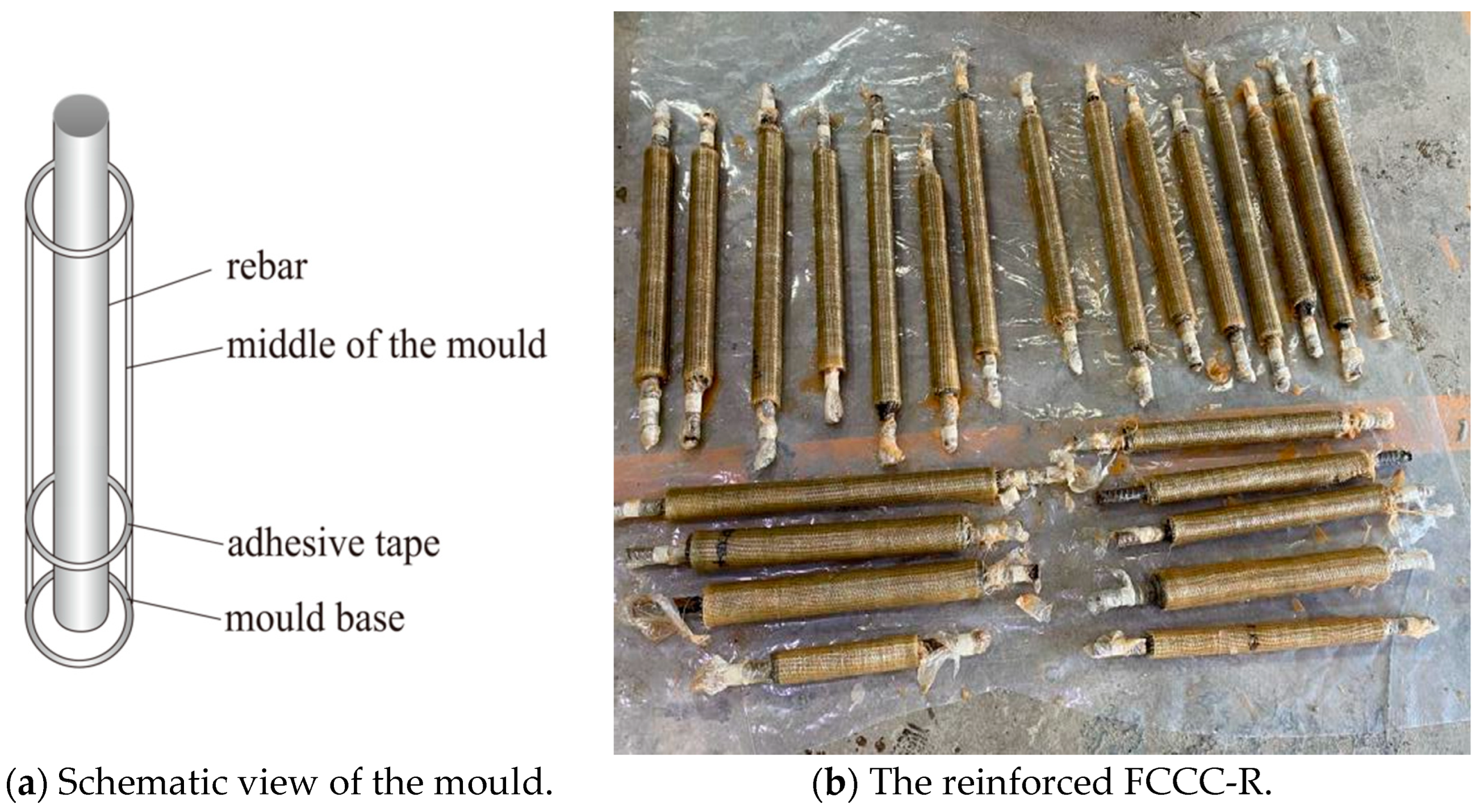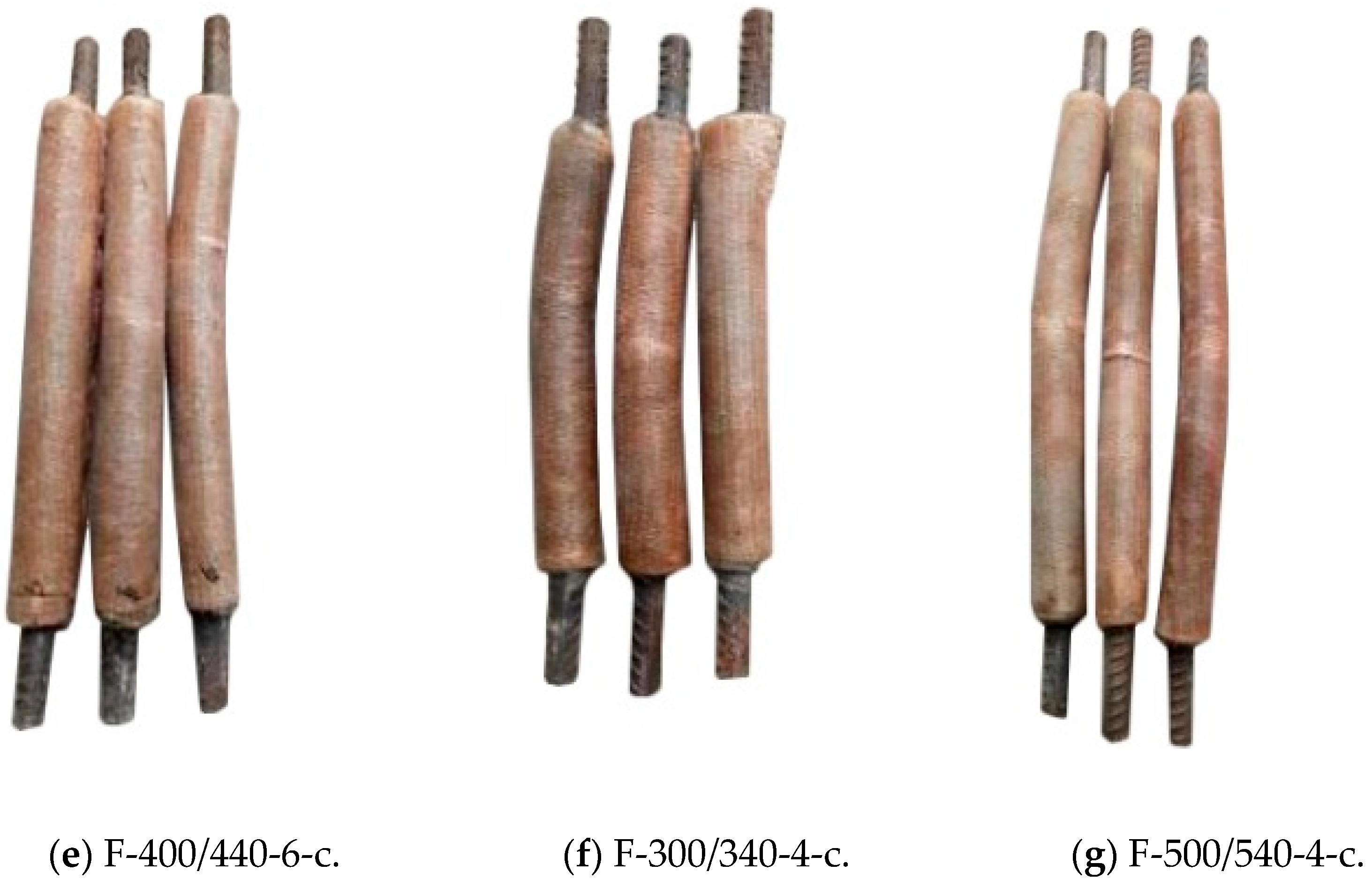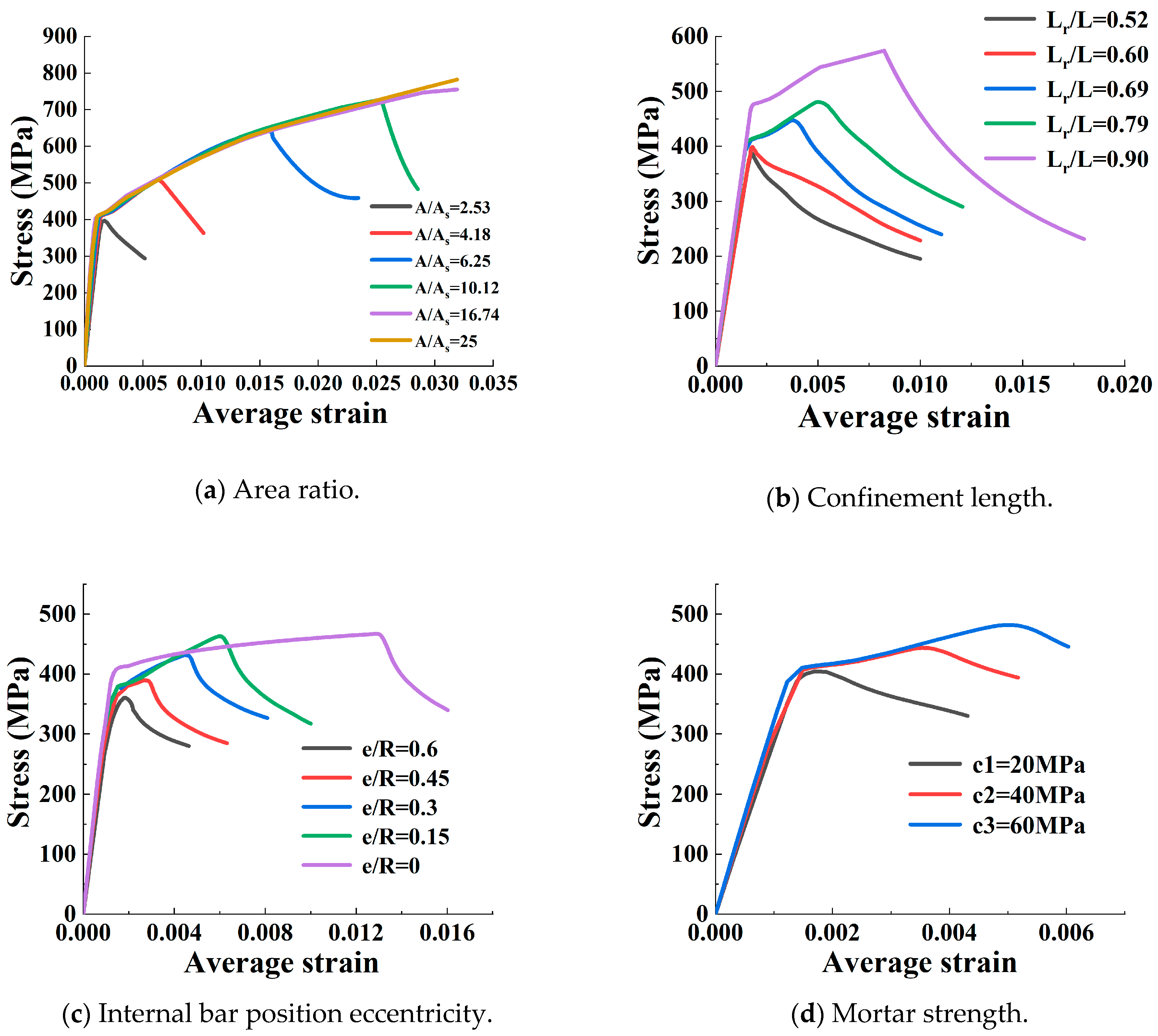Experimental and Numerical Investigation of Axial Compression Behaviour of FRP-Confined Concrete-Core-Encased Rebar
Abstract
1. Introduction
2. Overview of Test
2.1. Specimen Design
2.2. Specimen Preparation
2.3. Test Materials
2.3.1. Rebar
2.3.2. Mortar
2.3.3. FRP
2.4. Test Method
3. Test Result and Analysis
3.1. Test Phenomena and Mechanism Analysis
3.1.1. Rebar Buckling
3.1.2. Mechanism Analysis of FCCC-R Buckling Failure
3.2. Test Result Comparison and Analysis
3.2.1. Summary of Test Results
3.2.2. Analysis of Effect of Winding Angle on FCCC-R Axial Compression Performance
3.2.3. Analysis of Effect of Winding Thickness on FCCC-R Axial Compression Performance
3.2.4. Analysis of Effect of Slenderness Ratio on FCCC-R Axial Compression Performance
4. Finite Element Simulation and Parametric Analysis
4.1. Material Constitutive Model
4.2. Establishment of Finite Element Model
4.3. Verification Result of Finite Element
4.3.1. Failure Mode
4.3.2. Load–Displacement Curve
4.4. Parametric Study and Analysis
5. Conclusions
Author Contributions
Funding
Institutional Review Board Statement
Informed Consent Statement
Data Availability Statement
Conflicts of Interest
References
- Syntzirma, D.V.; Pantazopoulou, S.J.; Aschheim, M. Load-history effects on deformation capacity of flexural members limited by bar buckling. Eng. Struct. 2009, 136, 1–11. [Google Scholar] [CrossRef]
- Massone, L.M. Fundamental principles of the reinforced concrete design code changes in chile following the mw 8.8 earthquake in 2010. Eng. Struct. 2013, 56, 1335–1345. [Google Scholar] [CrossRef]
- Kashani, M.M.; Lowes, L.N.; Crewe, A.J.; Alexander, N.A. Nonlinear fiber element modelling of RC bridge piers considering inelastic buckling of reinforcement. Eng. Struct. 2016, 116, 163–177. [Google Scholar] [CrossRef]
- Wang, Z.Y.; Feng, P.; Zhao, Y.; Yu, T. FRP-confined concrete core-encased rebar for RC columns: Concept and axial compressive behavior. Compos. Struct. 2019, 222, 110915.1–110915.13. [Google Scholar] [CrossRef]
- Dhakal, R.P.; Su, J. Design of transverse reinforcement to avoid premature buckling of main bars. Earthq. Eng. Struct. Dyn. 2018, 47, 147–168. [Google Scholar] [CrossRef]
- Hashemi, S.S.; Vaghefi, M.; Hemmat, M. Evaluation the effects of stirrup spacing and buckling of steel reinforcing bars on the capacity of RC columns. Sci. Iran. 2017, 25, 1140–1151. [Google Scholar] [CrossRef]
- Pereiro-Barceló, J.; Bonet Senach, J.L.; Albiol-Ibáñez, J.R. Required tie spacing to prevent inelastic local buckling of longitudinal reinforcements in RC and FRC elements. Eng. Struct. 2018, 160, 328–341. [Google Scholar] [CrossRef]
- Lukkunaprasit, P.; Tangbunchoo, T.; Rodsin, K. Enhancement of seismic performance of reinforced concrete columns with buckling-restrained reinforcement. Eng. Struct. 2011, 33, 3311–3316. [Google Scholar] [CrossRef]
- Mitra, D.C.; Bindhu, K.R. Seismic performance of RC short columns with buckling restraint reinforcement. Mag. Concr. Res. 2019, 71, 163–174. [Google Scholar] [CrossRef]
- Ruangrassamee, A.; Sawaroj, A. Seismic enhancement of reinforced-concrete columns by rebar-restraining collars. J. Earthq. Tsunami. 2013, 6, 1250015.1–1250015.19. [Google Scholar] [CrossRef]
- Tang, Y.; Lu, X.; Wei, Y.; Hou, S. Experimental study on compressive behavior of concrete cylinders confined by a novel hybrid fiber-reinforced polymer spiral. Polymers 2022, 14, 4750. [Google Scholar] [CrossRef] [PubMed]
- Ye, Y.Y.; Zeng, J.J.; Li, P.L. A state-of-the-art review of FRP-confined steel-reinforced concrete (FCSRC) structural members. Polymers 2022, 14, 677. [Google Scholar] [CrossRef]
- Zhou, Y.; Hu, J.; Li, M.; Sui, L.; Xing, F. FRP-confined recycled coarse aggregate concrete: Experimental investigation and model comparison. Polymers 2016, 8, 375. [Google Scholar] [CrossRef]
- Wu, G.; Lu, Z. Study on the stress-strain relationship of FRP-confined concrete rectangular columns. J. Build. Struct. 2004, 25, 99–106. [Google Scholar]
- Li, P.; Wu, Y.F. Stress–strain model of FRP confined concrete under cyclic loading. Compos. Struct. 2015, 134, 60–71. [Google Scholar] [CrossRef]
- Micelli, F.; Mazzotta, R.; Leone, M.; Aiello, M.A. Review study on the durability of FRP-confined concrete. J. Compos. Construct. 2015, 19, 04014056. [Google Scholar] [CrossRef]
- Li, P.; Huang, D.; Li, R.; Yuan, F. Effect of aggregate size on the axial compressive behavior of FRP-confined coral aggregate concrete. Polymers 2022, 14, 3877. [Google Scholar] [CrossRef]
- Raza, A.; Ahmad, A. Prediction of axial compressive strength for FRP-confined concrete compression members. Civ. Eng. 2020, 24, 2099–2109. [Google Scholar] [CrossRef]
- Teng, J.G.; Lam, L. Compressive behavior of carbon fiber reinforced polymer-confined concrete in elliptical columns. J. Struct. Eng. 2002, 128, 1535–1543. [Google Scholar] [CrossRef]
- Cao, Y.; Wu, Y.F.; Jiang, C. Stress-strain relationship of FRP confined concrete columns under combined axial load and bending moment. Compos. Part B Eng. 2018, 134, 207–217. [Google Scholar] [CrossRef]
- Yu, T.; Lin, G.; Zhang, S.S. Compressive behavior of FRP-confined concrete-encased steel columns. Compos. Struct. 2016, 154, 493–506. [Google Scholar] [CrossRef]
- Feng, P.; Zhang, Y.; Bai, Y.; Ye, L. Strengthening of steel members in compression by mortar-filled FRP tubes. Thin-Walled Struct. 2013, 64, 1–12. [Google Scholar] [CrossRef]
- Jiang, C. Strength enhancement due to FRP confinement for coarse aggregate-free concretes. Eng. Struct. 2023, 277, 115370. [Google Scholar] [CrossRef]
- Zhao, D.B.; Pan, J.; Zhou, Y.W.; Sui, L.L.; Ye, Z.H. New types of steel-FRP composite bar with round steel bar inner core: Mechanical properties and bonding performances in concrete. Constr. Build. Mater. 2020, 242, 118062. [Google Scholar] [CrossRef]
- Deng, Z.C.; Liu, S.X. Experimental and theoretical research on ultra-high performance concrete confined by FRP pipe. J. Basic Sci. Eng. 2016, 24, 792–803. [Google Scholar]
- Hu, Z.J.; Pan, J.L.; Xu, T. Experimental research on stable carrying capacity of FRP strongly confined concrete reinforced columns. Ind. Arch. 2005, 35, 24–28. [Google Scholar]
- Cang, Y.Q. Research on Axial Compression and Seismic Performance of Steel Tube-GFRP-Sea Sand Concrete Column Based on Unified Theory. Master’s Thesis, Harbin Institute of Technology, Harbin, China, 2010. [Google Scholar]
- Liu, L.J. Experimental and Theoretical Study on Stability of Pultrusion GFRP Axial Compressive Members. Master’s Thesis, Nanjing University of Science and Technology, Nanjing, China, 2020. [Google Scholar]
- Ren, H.T.; Guo, X.; Wang, S.Y. Axial compression performance test and finite element analysis of FRP pipe-concrete-steel tube composite short columns. J. Dalian Univ. Technol. 2015, 55, 612–617. [Google Scholar]
- Chaht, F.L.; Mokhtari, M.; Benzaama, H. Using a Hashin criteria to predict the damage of composite notched plate under traction and torsion behavior. Frat. Integrita Strutt. 2019, 50, 331–341. [Google Scholar] [CrossRef]
- Son, J.; Fam, A. Finite element modeling of hollow and concrete-filled fiber composite tubes in flexure: Model development. Verif. Investig. Tube Parameters Eng. Struct. 2008, 30, 2656–2666. [Google Scholar]
- Liu, W.L.; Chang, X.L.; Zhang, X.J.; Hu, K.; Zhang, Y.H. Research on low velocity impact damage of composite materials based on improved Hashin criterion. Vib. Impact 2016, 35, 209–214. [Google Scholar]











| Rebar Type | Yield Strength (MPa) | Yield Strain | Tensile Strength (MPa) | Elastic Modulus (GPa) | Poisson’s Ratio |
|---|---|---|---|---|---|
| HRB400 | 409 | 0.00207 | 566 | 196.7 | 0.3 |
| Coupon Shape | Axial Compressive Strength (MPa) | Elastic Modulus (GPa) | Poisson’s Ratio |
|---|---|---|---|
| Cylinder | 34.44 | 27.76 | 0.21 |
| Longitudinal Tensile Strength (MPa) | Transverse Tensile Strength (MPa) | Shear Strength (MPa) | Longitudinal Elastic Modulus (GPa) | Transverse Elastic Modulus (GPa) | Shear Modulus (GPa) | Poisson’s Ratio |
|---|---|---|---|---|---|---|
| 760.2 | 55.1 | 217.1 | 45.1 | 2.7 | 14.9 | 0.23 |
| Specimen ID | Confinement Length (mm) | Loading Length (mm) | Layers | Confinement Thickness (mm) | Angle (from Inside to Outside) |
|---|---|---|---|---|---|
| F-400/440-4-a | 400 | 440 | 4 | 2.8 | 0°0°0°0° |
| F-400/440-4-b | 400 | 440 | 4 | 2.8 | −45° + 45°0°0° |
| F-400/440-4-c | 400 | 440 | 4 | 2.8 | 90°90°0°0° |
| F-400/440-2-c | 400 | 440 | 2 | 1.4 | 90°0° |
| F-400/440-6-c | 400 | 440 | 6 | 2.4 | 90°90°90°0°0°0° |
| F-300/340-4-c | 300 | 340 | 4 | 2.8 | 90°90°0°0° |
| F-500/540-4-c | 500 | 540 | 4 | 2.8 | 90°90°0°0° |
| R-340 | -- | 340 | -- | -- | -- |
| R-440 | -- | 440 | -- | -- | -- |
| R-540 | -- | 540 | -- | -- | -- |
| Specimen ID | L/d | Pmax (kN) | Umax (mm) | Pmax/Fy | Pmax/Pmax,s |
|---|---|---|---|---|---|
| F-400/440-4-a | 20 | 180.16 | 2.67 | 1.16 | 1.31 |
| F-400/440-4-b | 20 | 190.90 | 3.55 | 1.23 | 1.39 |
| F-400/440-4-c | 20 | 203.69 | 4.12 | 1.31 | 1.48 |
| F-400/440-2-c | 20 | 178.83 | 2.64 | 1.15 | 1.30 |
| F-400/440-6-c | 20 | 231.00 | 5.68 | 1.49 | 1.68 |
| F-300/340-4-c | 15.45 | 238.17 | 7.05 | 1.53 | 1.62 |
| F-500/540-4-c | 22.73 | 178.55 | 2.56 | 1.15 | 1.39 |
| R-340 | 15.45 | 146.63 | 0.82 | 0.94 | |
| R-440 | 20 | 137.63 | 0.84 | 0.89 | |
| R-540 | 22.73 | 128.42 | 0.89 | 0.83 |
| Specimen ID | Pmax (kN) | Pmax,M (kN) | Pmax/Pmax,M | Discrepancy |
|---|---|---|---|---|
| F-400/440-4-a | 180.16 | 176.00 | 1.02 | 2.31% |
| F-400/440-4-b | 190.90 | 176.97 | 1.08 | 7.30% |
| F-400/440-4-c | 203.69 | 200.84 | 1.01 | 1.40% |
| F-400/440-2-c | 178.83 | 170.64 | 1.05 | 4.58% |
| F-400/440-6-c | 231.00 | 230.78 | 1.00 | 0.10% |
| F-300/340-4-c | 238.17 | 233.48 | 1.02 | 1.97% |
| F-500/540-4-c | 178.55 | 173.98 | 1.03 | 2.56% |
| Parameter | Values |
|---|---|
| Area ratio, A/As | 2.53, 4.18, 6.25, 10.12, 16.74, 25 |
| Confinement length, Lr/L | 0.52, 0.60, 0.69, 0.79, 0.90 |
| Internal bar position eccentricity, e/R | 0.6, 0.45, 0.30, 0.15, 0 |
| Mortar strength, fc (MPa) | 20, 40, 60 |
Disclaimer/Publisher’s Note: The statements, opinions and data contained in all publications are solely those of the individual author(s) and contributor(s) and not of MDPI and/or the editor(s). MDPI and/or the editor(s) disclaim responsibility for any injury to people or property resulting from any ideas, methods, instructions or products referred to in the content. |
© 2023 by the authors. Licensee MDPI, Basel, Switzerland. This article is an open access article distributed under the terms and conditions of the Creative Commons Attribution (CC BY) license (https://creativecommons.org/licenses/by/4.0/).
Share and Cite
Lu, J.; Huang, H.; Li, Y.; Mou, T. Experimental and Numerical Investigation of Axial Compression Behaviour of FRP-Confined Concrete-Core-Encased Rebar. Polymers 2023, 15, 828. https://doi.org/10.3390/polym15040828
Lu J, Huang H, Li Y, Mou T. Experimental and Numerical Investigation of Axial Compression Behaviour of FRP-Confined Concrete-Core-Encased Rebar. Polymers. 2023; 15(4):828. https://doi.org/10.3390/polym15040828
Chicago/Turabian StyleLu, Jingzhou, Han Huang, Yunkai Li, and Tong Mou. 2023. "Experimental and Numerical Investigation of Axial Compression Behaviour of FRP-Confined Concrete-Core-Encased Rebar" Polymers 15, no. 4: 828. https://doi.org/10.3390/polym15040828
APA StyleLu, J., Huang, H., Li, Y., & Mou, T. (2023). Experimental and Numerical Investigation of Axial Compression Behaviour of FRP-Confined Concrete-Core-Encased Rebar. Polymers, 15(4), 828. https://doi.org/10.3390/polym15040828







